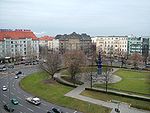St. George's Anglican Church, Berlin

St. George's Church (Englische Kirche zu St. Georg between 1885 and 1944) is an Anglican church in Berlin, Germany, a parish of the Diocese in Europe of the Church of England. The original building was erected on Monbijou Park in 1885, but during the Second World War was destroyed in allied bombings. The original site on Oranienburger Straße happened to be in what had become the Soviet sector of Berlin in 1945 and was therefore abandoned and the ruins removed in 1949. In 1950 the congregation built a new church on the corner of Preußenallee and Badenallee in Neu-Westend, part of the Westend locality of Berlin in the British sector. The church served as the garrison church of the British Army during the Allied occupation, and reverted to civilian control in 1994.
Excerpt from the Wikipedia article St. George's Anglican Church, Berlin (License: CC BY-SA 3.0, Authors, Images).St. George's Anglican Church, Berlin
Badenallee, Berlin Westend
Geographical coordinates (GPS) Address Website External links Nearby Places Show on map
Geographical coordinates (GPS)
| Latitude | Longitude |
|---|---|
| N 52.512222222222 ° | E 13.258611111111 ° |
Address
St. George’s Church
Badenallee 16
14052 Berlin, Westend
Germany
Open on Google Maps







